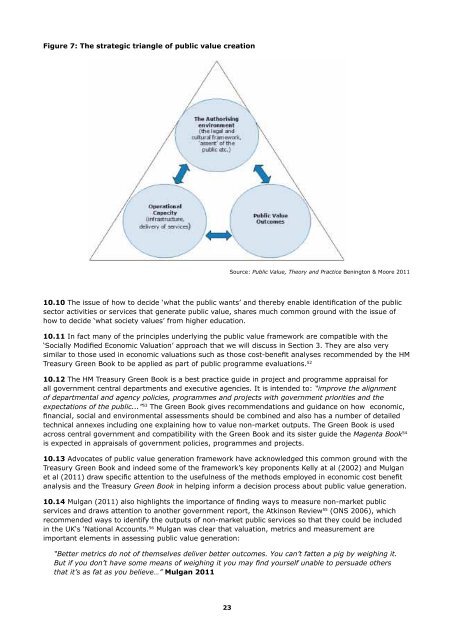Through a glass darkly Measuring the social value of universities
80096 NCCPE Social Value Report (2)
80096 NCCPE Social Value Report (2)
- No tags were found...
You also want an ePaper? Increase the reach of your titles
YUMPU automatically turns print PDFs into web optimized ePapers that Google loves.
Figure 7: The strategic triangle <strong>of</strong> public <strong>value</strong> creationSource: Public Value, Theory and Practice Benington & Moore 201110.10 The issue <strong>of</strong> how to decide ‘what <strong>the</strong> public wants’ and <strong>the</strong>reby enable identification <strong>of</strong> <strong>the</strong> publicsector activities or services that generate public <strong>value</strong>, shares much common ground with <strong>the</strong> issue <strong>of</strong>how to decide ‘what society <strong>value</strong>s’ from higher education.10.11 In fact many <strong>of</strong> <strong>the</strong> principles underlying <strong>the</strong> public <strong>value</strong> framework are compatible with <strong>the</strong>‘Socially Modified Economic Valuation’ approach that we will discuss in Section 3. They are also verysimilar to those used in economic valuations such as those cost-benefit analyses recommended by <strong>the</strong> HMTreasury Green Book to be applied as part <strong>of</strong> public programme evaluations. 5210.12 The HM Treasury Green Book is a best practice guide in project and programme appraisal forall government central departments and executive agencies. It is intended to: “improve <strong>the</strong> alignment<strong>of</strong> departmental and agency policies, programmes and projects with government priorities and <strong>the</strong>expectations <strong>of</strong> <strong>the</strong> public...” 53 The Green Book gives recommendations and guidance on how economic,financial, <strong>social</strong> and environmental assessments should be combined and also has a number <strong>of</strong> detailedtechnical annexes including one explaining how to <strong>value</strong> non-market outputs. The Green Book is usedacross central government and compatibility with <strong>the</strong> Green Book and its sister guide <strong>the</strong> Magenta Book 54is expected in appraisals <strong>of</strong> government policies, programmes and projects.10.13 Advocates <strong>of</strong> public <strong>value</strong> generation framework have acknowledged this common ground with <strong>the</strong>Treasury Green Book and indeed some <strong>of</strong> <strong>the</strong> framework’s key proponents Kelly at al (2002) and Mulganet al (2011) draw specific attention to <strong>the</strong> usefulness <strong>of</strong> <strong>the</strong> methods employed in economic cost benefitanalysis and <strong>the</strong> Treasury Green Book in helping inform a decision process about public <strong>value</strong> generation.10.14 Mulgan (2011) also highlights <strong>the</strong> importance <strong>of</strong> finding ways to measure non-market publicservices and draws attention to ano<strong>the</strong>r government report, <strong>the</strong> Atkinson Review 55 (ONS 2006), whichrecommended ways to identify <strong>the</strong> outputs <strong>of</strong> non-market public services so that <strong>the</strong>y could be includedin <strong>the</strong> UK‘s ‘National Accounts. 56 Mulgan was clear that valuation, metrics and measurement areimportant elements in assessing public <strong>value</strong> generation:“Better metrics do not <strong>of</strong> <strong>the</strong>mselves deliver better outcomes. You can’t fatten a pig by weighing it.But if you don’t have some means <strong>of</strong> weighing it you may find yourself unable to persuade o<strong>the</strong>rsthat it’s as fat as you believe…” Mulgan 201123


